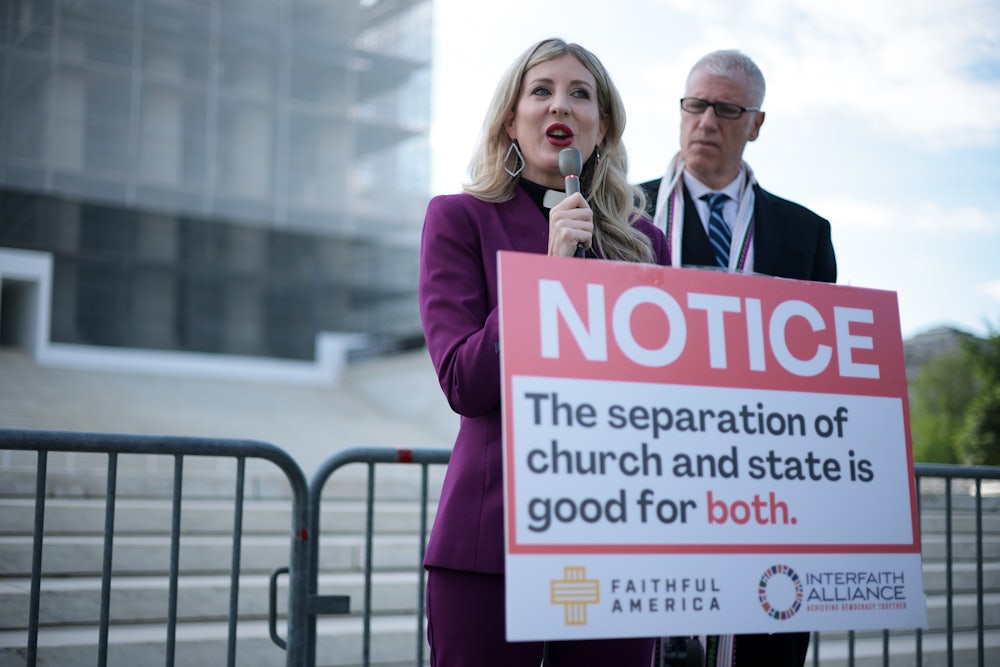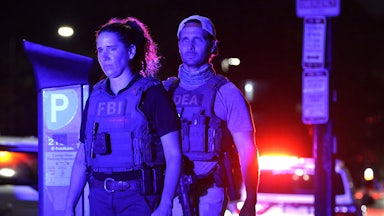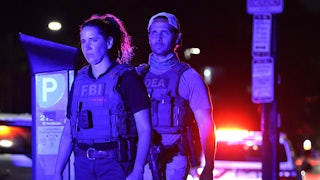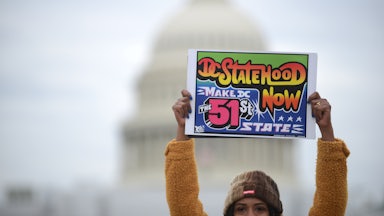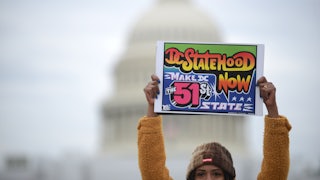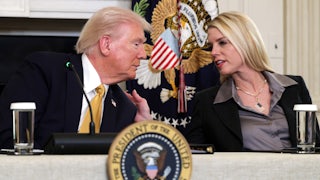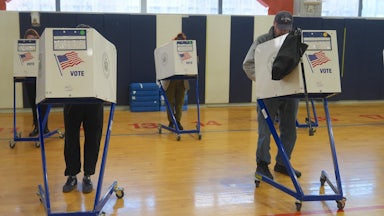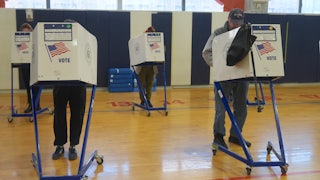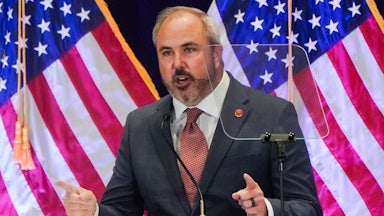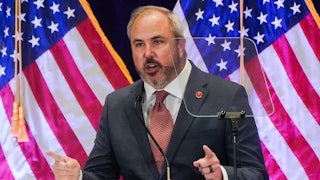The Supreme Court appears ready to approve the nation’s first religious charter school in Oklahoma, dealing a monumental blow to the separation of church and state by effectively writing the establishment clause out of the Constitution.
In oral arguments in Oklahoma State Charter Board v. Drummond on Wednesday, the high court’s conservative majority saw no issue with allowing the Catholic Church to operate a state-funded public school, despite the state and federal constitutional bans on such entanglements. If anything, they appeared offended by the suggestion that it wouldn’t be constitutional.
“If you go and apply to be a charter school and you’re an environmental studies school, or you’re a science-based school, or you’re a Chinese immersion school, or you’re an English grammar–focused school, you can get in,” Justice Brett Kavanaugh opined at one point. “And then you come in and you say, ‘Oh, we’re a religious school.’ It’s like, ‘Oh, no, can’t do that, that’s too much. That’s scary. We’re not going to do that.’”
Conservative Christians enjoy unparalleled power over American public life these days. That did not stop Kavanaugh and his associates from adopting a downtrodden mien. “Our cases have made very clear, and I think those are some of the most important cases we’ve had, [that] you can’t treat religious people and religious institutions and religious speech as second-class in the United States,” he continued.
Oral arguments can be an imperfect predictor of case outcomes, so the court may ultimately rule against the state charter board. Justice Amy Coney Barrett’s recusal from the case also alters the ideological balance of power: Only one conservative defection would be necessary to deadlock the court and leave the lower court’s ruling against the board intact.
But the court’s five remaining conservative justices on Wednesday did not sound like they were having second thoughts. If anything, they seemed eager to compel American taxpayers to subsidize religious schools that teach doctrines and beliefs with which they may disagree, as part of their broader war on secularism. Two and a half centuries of religious pluralism—and the church-state separation that helps make it possible—could be imperiled.
The case centers on St. Isidore of Seville Catholic Virtual School, a proposed charter school in Oklahoma that was organized with the backing of the state’s Catholic bishops. State Catholic leaders hope that the school will allow them to more effectively educate members of their flock in far-flung rural portions of the state where brick-and-mortar Catholic schools are logistically unfeasible.
The Catholic Church operates thousands of private schools in the United States, which generally operate without taxpayer funds. The Supreme Court is more than familiar with this reality. Five of the six conservative justices attended private Catholic school for at least the latter portion of their K-12 education. Kavanaugh and Justice Neil Gorsuch even attended the same one at the same time: Georgetown Prep, a Jesuit-run private school in suburban Maryland.
St. Isidore’s leaders opted to apply for charter school status instead. While the legal nature of charter schools can vary from state to state, they are unambiguously part of the public school system in Oklahoma. State law defines them as a “public school established by contract” and requires that they be open to all students, free of charge, and subject to various state laws and regulations that only bind “normal” public schools.
The school’s backers do not intend for it to resemble a public school. St. Isidore is meant to be, in the words of one local Catholic leader, “a fully Catholic school—Catholic in every way, Catholic in teaching, Catholic in employment.” But Oklahoma law limits how charter schools can interact with religion. Charter schools can’t be affiliated with a “a nonpublic sectarian school or religious institution” and must be “nonsectarian” in all operations, including curriculum and hiring practices.
Oklahoma’s state constitution also requires its public schools to be “free from sectarian control.” That would be a tall order for St. Isidore. The school told state officials that it would comply with state and federal law “with priority given to the Catholic Church’s understanding of itself and its rights and its obligations pursuant to the Code of Canon Law and the catechism of the Catholic Church.” While many private schools operate along those lines, public schools do not.
One does not need to be a lawyer to see some potential legal troubles here. To that end, Oklahoma Attorney General Gentner Drummond, a Republican, warned the board against approving the creation of a charter school that appeared to be illegal and unconstitutional. After the board ignored him in 2023 and approved it anyway, he sued the board in an effort to reverse its decision. The Oklahoma Supreme Court sided with him in a decision last June.
Upholding that ruling should be an easy task for the justices. The First Amendment declares that the government “shall make no law respecting an establishment of religion” or “prohibiting the free exercise thereof.” Those provisions are respectively known as the establishment clause and the free exercise clause. Together, they form the bulwark of American religious freedom.
Working in tandem, the two clauses set the early American republic apart from the European powers. The establishment clause generally prevents the government from creating something akin to the Church of England, where clergy are appointed by the state and serve in the legislature. It protects minority denominations and faiths from competition with a state-backed church, just as the free exercise clause shields them from more direct infringements on their liberty.
Navigating between these two clauses is sometimes tricky. In 1970, for example, the Supreme Court upheld a New York law that specifically offered property-tax exemptions to houses of worship. The justices articulated a form of secularism that recognized a robust establishment clause while also allowing the government to avoid imposing burdens on religious practices.
“The general principle deducible from the First Amendment and all that has been said by the Court is this: that we will not tolerate either governmentally established religion or governmental interference with religion,” then–Chief Justice Warren Burger wrote for the court. “Short of those expressly proscribed governmental acts, there is room for play in the joints productive of a benevolent neutrality which will permit religious exercise to exist without sponsorship and without interference.”
The “play at the joints” metaphor later guided the court’s approach in the 2004 case Locke v. Davey, where a Washington state postgraduate student challenged a provision that restricted a state scholarship program from being used to fund doctoral degrees in divinity studies. Chief Justice William Rehnquist ruled that the state had a compelling interest in refusing to allow its public funds to be spent on religious vocational educations.
Things began to change in 2017 when the justices heard a dispute between the Missouri Department of Natural Resources and Trinity Lutheran Church, which is located in Columbia, Missouri. Missouri ran a grant program that allowed schools and day cares to resurface their playgrounds with rubber from recycled tires. When the church’s day care applied to the program in 2012, the agency turned it down, citing a state constitutional provision that forbade spending public funds “in aid of any church, sect or denomination of religion.”
On its face, Trinity Lutheran Church v. Comer was a classic establishment clause case. Courts have long interpreted that clause to allow states to avoid funding houses of worship and religious institutions. When the church sued the state by arguing a free exercise clause violation, however, the state of Missouri took the unusual stance that the establishment clause did not apply in the case and ceded that argument in the lower courts.
“You say we don’t have to look at the establishment clause,” Chief Justice John Roberts asked James Layton, who represented Missouri, at oral arguments. “In your brief, you said there’s no establishment clause problem here.” Layton confirmed that “in the State’s view, there is not an establishment clause violation” and attributed that legal strategy to “[Missouri] Governor [Eric] Greitens’s decision to proceed differently.”
Greitens, who briefly served as governor in 2017 and 2018 before resigning amid scandal, had issued an executive order to the state Department of Natural Resources to allow churches and religious entities to participate in the program, disregarding the state constitution’s ban on such practices. At the same time, the governor urged the justices to decide the case despite the change in state policy.
Faced with that sharply tilted playing field, the court’s conservative majority easily ruled in favor of the church. It disregarded the establishment clause question and held that the state’s actions amounted to unconstitutional discrimination against religious groups under the free exercise clause. “The exclusion of Trinity Lutheran from a public benefit for which it is otherwise qualified, solely because it is a church, is odious to our Constitution all the same, and cannot stand,” Roberts wrote for the majority.
In dissent, Justice Sonia Sotomayor castigated the court for accepting the two sides’ fait accompli. “The Establishment Clause does not allow Missouri to grant the Church’s funding request because the Church uses the Learning Center, including its playground, in conjunction with its religious mission,” she wrote. “The Court’s silence on this front signals either its misunderstanding of the facts of this case or a startling departure from our precedents.”
The Trinity Lutheran majority’s approach to religious discrimination was also revolutionary. The most prominent free exercise clause cases typically dealt with the disfavoring of specific religious practices and traditions: Amish families who do not want their children to attend public high school, Jehovah’s Witnesses who decline to stand during the Pledge of Allegiance, Native Americans who use peyote for spiritual practices, and so on. That approach promoted American religious pluralism on a neutral, secular basis.
In Trinity Lutheran, however, the government reinterpreted the free exercise clause by framing secularism as the enemy. “The express discrimination against religious exercise here is not the denial of a grant, but rather the refusal to allow the church—solely because it is a church—to compete with secular organizations for a grant,” Roberts wrote. Secularism and nonsectarianism were no longer treated as a safe, neutral default for the government but as a special burden for religious litigants to overcome.
Armed with Trinity Lutheran, conservative religious groups soon launched a series of challenges to various nonsectarian bans on disbursing public funds to religious entities. In the 2020 case Espinoza v. Montana Department of Revenue, the court’s conservative majority ruled against the state for refusing to allow a tuition-assistance program for private school students to be used for attending religious schools.
The Montana state constitution had barred state officials from sending any public funds to schools controlled by a “church, sect, or denomination.” The Supreme Court invoked the free exercise clause to circumvent it. “To be eligible for government aid under the Montana Constitution, a school must divorce itself from any religious control or affiliation,” Roberts wrote for the court, quoting from Trinity Lutheran. “Placing such a condition on benefits or privileges ‘inevitably deters or discourages the exercise of First Amendment rights.’”
Two years later, in Carson v. Makin, the court ruled against a tuition-assistance scheme for rural students who lack access to public schools. The program allowed students to attend out-of-district public schools or private ones, so long as the private ones were “nonsectarian.” Roberts, again writing for the court, held that “a state’s antiestablishment interest does not justify enactments that exclude some members of the community from an otherwise generally available public benefit because of their religious exercise.”
Justice Stephen Breyer, who was part of the Trinity Lutheran majority, argued in dissent that the Carson court had gone far beyond what he had supported before. Allowing a church day care to resurface its playground, he claimed, was substantially different from requiring the state to directly fund religious education. “These distinctions are important,” Breyer explained. “The very point of the Establishment Clause is to prevent the government from sponsoring religious activity itself, thereby favoring one religion over another or favoring religion over nonreligion.”
Roberts’s response did not so much dispute his colleague’s critique as prove it. “Justice Breyer stresses the importance of ‘government neutrality’ when it comes to religious matters, but there is nothing neutral about Maine’s program,” the chief justice opined. “The state pays tuition for certain students at private schools—so long as the schools are not religious. That is discrimination against religion.” In short, the free exercise clause had effectively swallowed the establishment clause whole.
Kavanaugh all but admitted this in Wednesday’s oral arguments. In a discussion about the emergence of the federal charter school program in 1994, he noted that “at that point, it was considered constitutional to discriminate against religious entities.” The court’s recent case law, he explained, “has changed that and said, ‘No, it’s not constitutional to discriminate against private religions.’” The result, he concluded, was a “different constitutional understanding” than before.
Other justices echoed his sentiments. Justice Samuel Alito embarked on a series of grievance-laden questions about other types of charter schools that Oklahoma could theoretically create. He asked Gregory Garre, who represented the state Attorney General’s Office, if Oklahoma could set up a school with music classes that exclusively “include jazz and hip-hop and rap and music from non-European countries.” (Probably, Garre replied.) He also asked whether the state could set up a “progressive school” that teaches The 1619 Project. (No, said Garre about the latter, based on the state’s curriculum requirements.)
Alito’s implication was that if the other side could set up charter schools, why couldn’t his side do it? He even offered a rambling, homophobic hypothetical. “Could a school say we’re going to be an LGBTQ+ friendly school, so that the books that elementary schoolchildren are going to read are going to have lots of LGBTQ+ characters [and] same-sex couples, and they are going to send the message that this is a perfectly legitimate lifestyle?” he asked. “They’re going to tell the little kids, if your parents may say you’re a boy or a girl, that doesn’t mean you really are a boy or a girl. Could they do that?” (No, replied Garre, because state law forbids those teachings.)
While none of Alito’s conservative colleagues echoed his ugly sentiments, they all appeared driven by the same sense of cultural and social alienation that shapes Christianity’s conservative believers in modern society. One of Alito’s questions asked whether a charter school in Oklahoma could “seek to inculcate a secular viewpoint—not just a secular viewpoint but a particular secular viewpoint?” Garre was momentarily nonplussed. “With respect, I don’t know what you mean by that.”
For the high court, secularism and nonsectarianism are no longer important principles of American religious freedom but an enemy of religion itself that must be torn down to ensure its survival. I have no doubt that this is a strong, sincerely held belief by the conservative justices, and that they fervently hope that it will help them regain some kind of lost perceived social and cultural hegemony. The only problem is that it is leading them to an understanding of the religion clauses—and the establishment clause, in particular—that is antithetical to the spirit, letter, and purpose of the constitutional text.
